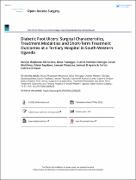| dc.contributor.author | Mvuyo Maqhawe, Sikhondze | |
| dc.contributor.author | Deus, Twesigye | |
| dc.contributor.author | Charles Newton, Odongo | |
| dc.contributor.author | David, Mutiibwa | |
| dc.contributor.author | Edson, Tayebwa | |
| dc.contributor.author | Leevan, Tibaijuka | |
| dc.contributor.author | Samuel D, Ayana | |
| dc.contributor.author | Carlos Cabrera, Dreque | |
| dc.date.accessioned | 2023-07-19T14:07:46Z | |
| dc.date.available | 2023-07-19T14:07:46Z | |
| dc.date.issued | 2022 | |
| dc.identifier.citation | Mvuyo Maqhawe Sikhondze, Deus Twesigye, Charles Newton Odongo, David Mutiibwa, Edson Tayebwa, Leevan Tibaijuka, Samuel D Ayana & Carlos Cabrera Dreque (2022) Diabetic Foot Ulcers: Surgical Characteristics, Treatment Modalities and Short-Term Treatment Outcomes at a Tertiary Hospital in South-Western Uganda, Open Access Surgery, , 75-87, DOI: 10.2147/OAS.S384235 | en_US |
| dc.identifier.uri | https://ir.sun.ac.ug//handle/123456789/69 | |
| dc.description.abstract | Abstract
Background: Diabetic foot ulcers (DFUs) are a prevalent and serious consequence of poorly controlled diabetes. Hospitalizations are frequent among DFU patients, and these patients are at risk of lower extremity amputations (LEA). Uganda has few studies detailing DFUs and their management. We described the surgical characteristics, treatment modalities and short-term treatment outcomes of DFUs at Mbarara Regional Referral Hospital, in southwestern Uganda.
Methods: A prospective cohort study involving 62 patients with DFUs was conducted from February 2021 to September 2021. We
captured socio-demographic data, surgical characteristics, treatment and treatment outcomes of DFUs over a 5-week follow-up period, through an interviewer-administered structured questionnaire. Descriptive statistics were used at analysis.
Results: The mean age of participants was 57.0 ± 12.27 years, comprising 35 (56.5%) females. Majority had diabetes mellitus (DM)
for more than 10 years, predominantly type 2 (93.5%), and 33.9% with very poor glycaemic control (HBA1c>9.5%). Most ulcers
involved the toes (27.4%), with 80.7% being large (>3 cm2
). Severe DFUs (Wagner grade 3–5) were seen in 66.2% of patients.
Clinically infected ulcers mainly had Pseudomonas spp cultured. Arterial occlusion was detected in 35.5% through lower extremity
Doppler ultrasonography. Initial surgical interventions were surgical debridement and LEA performed in 50.0% and 46.8%, respec tively. Eight (42.1%) patients suffered surgical site infection, while 26.3% had persistent gangrene after initial surgery. Revision
surgery was performed in 25.8% of the participants. Mortality rate was 1.6%, and mean length of hospital stay was 17.0 ± 11.1 days.
Conclusion: More than half of the patients had advanced DFUs (Wagner grades 3–5). Poor glycemic control and late presentation
were common. Lower extremity amputation was a common initial treatment modality for DFUs. Routine lower extremity Doppler
ultrasonography is recommended to assess peripheral arterial disease for DFU patients. Wound swabbing for culture and sensitivity
testing is encouraged for appropriate antibiotic coverage | en_US |
| dc.language.iso | en | en_US |
| dc.publisher | Open Access Surgery | en_US |
| dc.subject | diabetic foot ulcer, Wagner classification, Uganda | en_US |
| dc.title | Diabetic Foot Ulcers: Surgical Characteristics, Treatment Modalities and Short-Term Treatment Outcomes at a Tertiary Hospital in South-Western Uganda | en_US |
| dc.type | Article | en_US |

